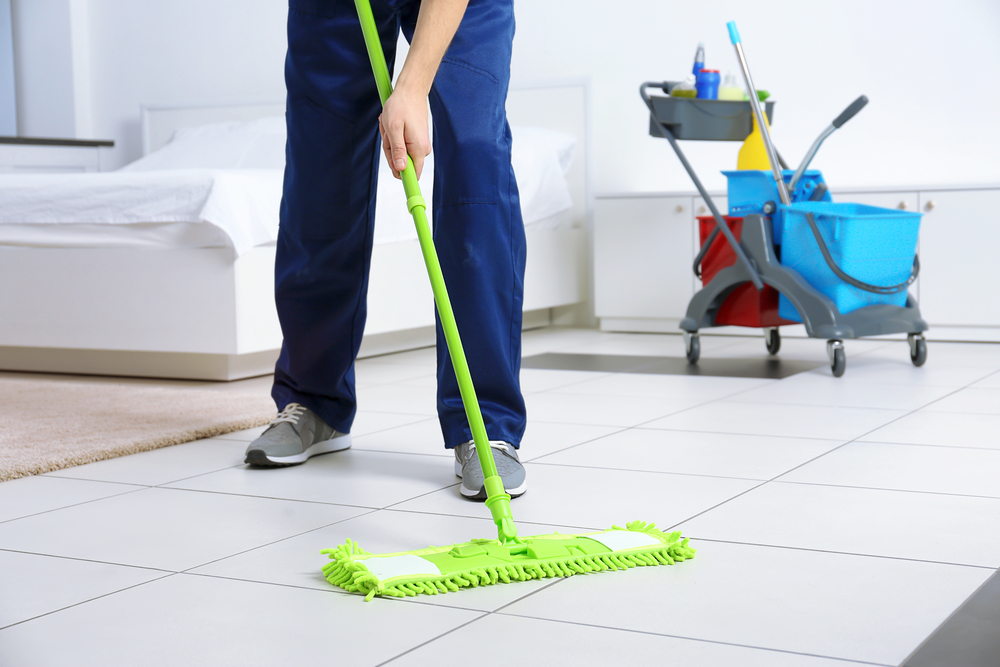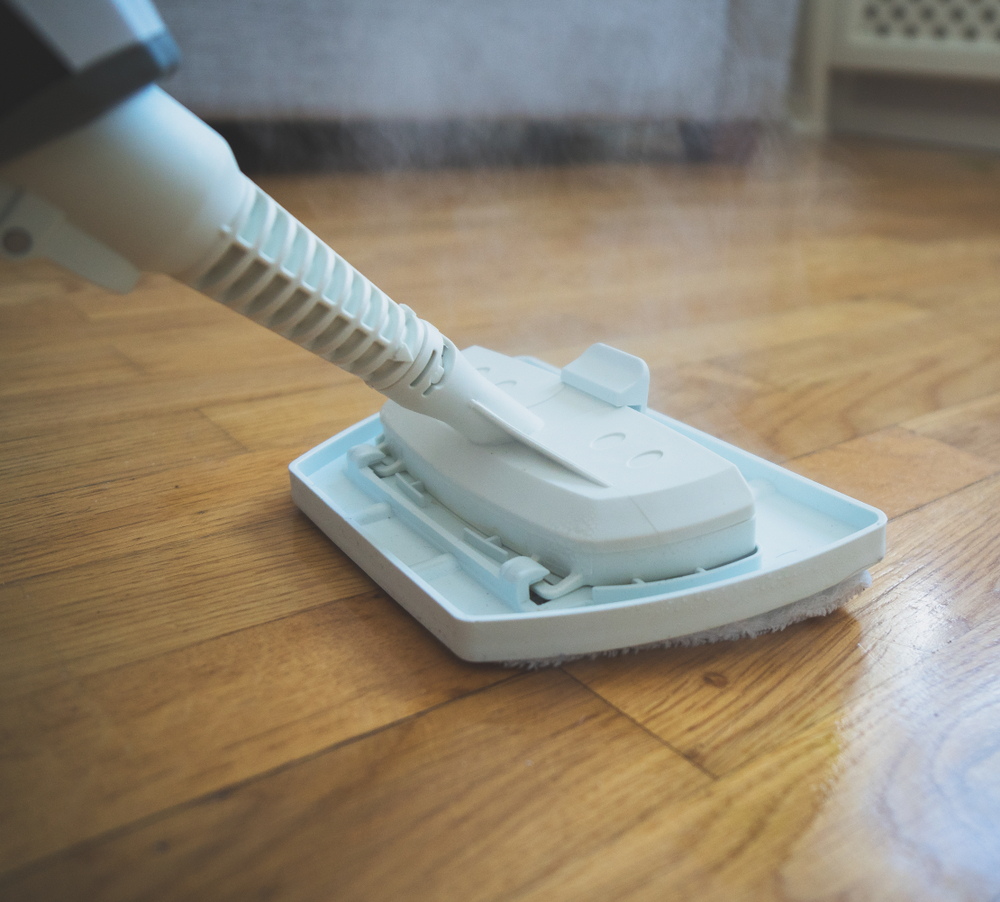How to Care for Laminate Flooring
Laminate flooring looks better than ever with realistic wood grain and multiple style options, including stone and tile finishes. And although this flooring option is a durable one, it also requires regular care to keep it looking great. Since you can’t refinish laminate, you want to protect it from the beginning to make it last longer.
Clean the Floor Regularly
Basic laminate floor care starts with your cleaning routine. Any moisture, dirt or debris can dull the finish and leave the floor looking worn, so you want to keep it off the surface as much as possible. Start with basic sweeping or vacuuming on a daily basis or any time you notice dirt on the floor. It’s best to sweep along the lines of the floor to help loosen tiny debris that gets into the joints. If you use a vacuum, add an attachment meant for hard-surface floors without a rotating brush, which can cause tiny scratches in the laminate.
Even though laminate is strong overall, it can be easily damaged by water. That means you don’t want to swish a soaking wet mop over the surface or use a steam mop to clean it. You can spot clean the floor with a soft, damp cloth to minimize moisture exposure. If your floor needs an overall cleaning, use a soft mop that’s just damp instead of sopping wet. Wipe the floor with a microfiber cloth afterward to remove any remaining moisture.
Unless your floor is really dirty, you likely don’t need anything other than water to clean it. However, you can buy a floor cleaner designed for laminate flooring that should be safe to use. If you use any type of cleaning product, apply it to the mop instead of putting it directly on the floor to avoid damage and streaking. A small amount of vinegar can give your mop water a boost for extra cleaning power without damaging the laminate.
Handle Stains Properly
You’re bound to spill something on your laminate eventually, no matter how careful you are. Wiping up any spills immediately can prevent a stain from setting and cut down on the risk of moisture damage. But some stains require something more than just a soft cloth to remove.
Rubbing alcohol can safely remove several types of stains, including ink, crayon marks, nail polish and shoe polish. Window cleaner can help remove blood from laminate flooring. If you get grease or tar on the floor, use mineral spirits to lift the marks. Candle wax is easy to scrape off after it hardens, but you should only use a plastic knife or credit card for scraping. Never use metal. Chewing gum can be removed with a similar approach, but put a small bag of ice on the gum first to harden it.
Scuffs from shoes are common on any type of hard-surface floor, including laminate. The very shoes that make the marks may help remove them. Hold the shoe in your hand and lightly press the heel over the scuff mark as you twist and apply pressure. This trick works best with shoes that have light-colored soles. Tennis balls and erasers rubbed onto the scuff can also remove the mark.
Protect Your Laminate From Potential Damage
Give your laminate flooring the best chance possible of lasting by protecting it from common causes of damage. Furniture pads on the bottoms of furniture legs prevent scratching as the piece shifts. Rugs or mats on the busiest parts of the floor cut down on worn spots. It’s also a good idea to put down a mat near any exterior entrances to soak up moisture from shoes and keep dirt from getting on the laminate.
Avoiding certain cleaners and tools can also help prevent damage. Skip any harsh, abrasive or soap-based cleaners that might hurt the laminate surface. Bleach should never go onto laminate flooring. Avoid steel wool or any type of scrubber or sponge with an abrasive surface.
Polish and wax are also things to avoid with laminate flooring. It seems like waxing a laminate floor would restore its shine, but it can have the opposite effect, leaving your floor cloudy and dull. Wax can also cause build-up on the flooring.

Dos and Don’ts of Laminate Flooring
We all know that the flooring of an area plays a great role in deciding the appearance of the place. This is applicable for residential as well as commercial spaces. Among the different kinds of flooring materials that are popular with people, laminate flooring needs special mention. The most significant advantage of laminate floors is that they resemble the looks and style of hardwood floors, but they are way cheaper and come in wide varieties too. If laminate floors are maintained and cleaned properly, they keep on shining for years. Certain things have to be kept in mind when it comes to maintaining laminate flooring near me. In this article, we will discuss some of the dos and don’ts of laminate flooring:
- Don’t Allow Stains to Settle on the Floor – Spills are not uncommon. But try handling the spills as soon as they happen. Take a clean cloth and wipe the spill immediately before it seeps and gets soaked by the flooring. Liquids can damage laminate floors and so, they should be avoided.
- Read Cleaning Instructions of Laminate Flooring – When you purchase laminate flooring material, you will be given a manual with cleaning instructions by the manufacturer. There are specific recommendations by different brands, and these should be followed diligently to keep your laminate flooring in pristine condition.
- Refrain from Using Excessive Water on Laminate Floors – For laminate flooring, traditional mopping methods are a strict no-no. There are chances that water might seep into the seams of the floor and cause damage like floor bubbling or swelling. Staining or fading of the flooring is bound to happen with too much use of water on such floors.
- Mop Laminate Floors Carefully Once in Every Two Months – For preserving freshness of laminate floors, mop them once in every two months. Use damp mop on the floor as they are gentle. For regular mops, ensure that they are wrung thoroughly so that they are almost dry and then mop the laminate floor.
- Refrain from Using Abrasive Tools – Scratching is a common problem with laminate floors. Therefore, abrasive tools like steel wool or sandpaper must be avoided on these floors. Use a dust mop or a soft-bristle broom for cleaning the floor. Avoid a rotating brush or a beater bar when using a vacuum cleaner, as that might lead to scratches on the surface.
- Trim Nails of Your Pets – This is not a flooring tip directly, but it helps in maintaining laminate flooring. Pets like cats, dogs, and even birds have sharp nails and might scratch the laminate flooring with the nails. Trim the nails of your pets so that damage to the floor can be averted.
- Choose Cleaning Products Specifically Made for Laminate Floors – When you are choosing cleaning products, make sure that you buy products that are specifically made for laminate floors. Using other kinds of products might leave residue or streaks on the floors, and cause damage to the floor as well.

How to Mop Laminate Floors
Glide a microfibre mop sprayed in laminate floor cleaning solution across your floor. If you don’t want to buy a solution, you can easily make your own which is equally effective. Simply combine 1 part vinegar and 3 parts water together. Add 1 teaspoon of washing up liquid and mix your concoction together before putting it in a spray bottle. As bizarre as it sounds to use vinegar on flooring, it’s actually a remarkable cleaning solution that can achieve shiny results.
Lightly dampen your mop by spraying on some solution, then tackle your flooring. Remember to drain your mop if it absorbs too much water, as you don’t want your flooring to get too wet. After cleaning, allow your flooring to dry. Open the windows and doors for extra ventilation to speed up the drying process.

What can go wrong when cleaning laminate?
As well as avoiding steam, it helps to prevent any dirt or damage to your laminate floor in the first place. If you haven’t already, invest in a doormat to stop dust and dirt travelling through to your new flooring. If you find your floor is prone to scratches, try putting furniture protectors underneath your chairs and tables. Last but not least, be quick to respond to any accidental spillages. Use a damp cloth to blot up spills as soon as they happen and your flooring should remain good as new.
After your laminate flooring is thoroughly cleaned, try to keep it in the best condition possible. It’s recommended that you do not use polish, varnish or wax on laminate flooring, as most types have a pre-finished wear layer which will never need further treatment.
Can You Use Steam On A Laminate Floor
Although the surface is water-resistant, laminate flooring has an inner core which is made up of high-density fibreboard. So while the odd spill is okay, excessive moisture could attack the inner core and damage your new flooring. But while a wet mop is a definite no, do steam cleaners have the same damaging effects?
Unfortunately, no. Laminate flooring is sensitive to heat and moisture, so the humidity from your steam mop can cause harm. It won’t cause as much damage as a wet mop, but could eventually cause your floor to warp, loosen or peel. Therefore, even if your steam mop says it will work on laminate floors, it’s best to stick to avoid steam altogether.






















